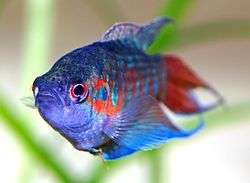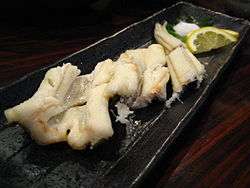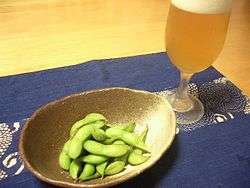Definify.com
Definition 2025
魚
魚
Translingual
| Stroke order | |||
|---|---|---|---|

| |||
Han character
魚 (radical 195 魚+0, 11 strokes, cangjie input 弓田火 (NWF), four-corner 27336, composition ⿳⺈田灬)
- Kangxi radical #195, ⿂ (“fish”).
Derived characters
- Index:Chinese radical/魚
Descendants
- 鱼, 𩵋
References
- KangXi: page 1465, character 1
- Dai Kanwa Jiten: character 45956
- Dae Jaweon: page 1998, character 1
- Hanyu Da Zidian: volume 7, page 4674, character 1
- Unihan data for U+9B5A
Chinese
| trad. | 魚 | |
|---|---|---|
| simp. | 鱼 | |
| alt. forms |
𤉯 𤋳 𩵋 |
|
Glyph origin
| Historical forms of the character 魚
| |||
|---|---|---|---|
| Oracle bone script | Bronze inscriptions | Large seal script | Small seal script |
 |
 |
 |
 |
| Characters in the same phonetic series (魚) (Zhengzhang, 2003) | |
|---|---|
| Old Chinese | |
| 蘇 | *sŋaː |
| 穌 | *sŋaː |
| 魚 | *ŋa |
| 漁 | *ŋa |
| 䱷 | *ŋa |
Pictogram (象形) – pictographic representation of a fish.
Etymology
From Proto-Sino-Tibetan *s-ŋja. Cognate with 漁 (OC *ŋa, “to fish”).
Pronunciation
- Mandarin
- (Standard Chinese, Beijing)+
- Pinyin:
- Zhuyin: ㄩˊ
- Wade-Giles: yü2
- Gwoyeu Romatzyh: yu
- IPA (key): /y³⁵/
-

- (Standard Chinese, Beijing)+
- Cantonese
- (Standard Cantonese, Guangzhou)+
- Jyutping: jyu4, jyu4-2
- Yale: yùh, yú
- Cantonese Pinyin: jy4, jy4-2
- IPA (key): /jyː²¹/, /jyː²¹⁻³⁵/
- (Taishanese, Taicheng)
- Wiktionary: ngui3, ngui3*
- IPA (key): /ᵑgui²²/, /ᵑgui²²⁻²²⁵/
- (Standard Cantonese, Guangzhou)+
- Hakka
- (Sixian, incl. Miaoli and Meinong)
- Pha̍k-fa-sṳ: ǹg
- Hakka Romanization System: ngˇ
- Hagfa Pinyim: ng2
- IPA: /ŋ̍¹¹/
- (Sixian, incl. Miaoli and Meinong)
- Min Dong
- (Fuzhou)
- Bàng-uâ-cê: ngṳ̀
- IPA (key): /ŋy⁵³/
- (Fuzhou)
- Min Nan
- (Hokkien: Xiamen, Zhangzhou, Kaohsiung, Tainan, Taichung, Yilan, Hsinchu)
- Pe̍h-ōe-jī: hî
- Tâi-lô: hî
- Phofsit Daibuun: hii
- IPA (Xiamen): /hi²⁴/
- IPA (Zhangzhou): /hi¹³/
- IPA (Kaohsiung): /hi²³/
- (Hokkien: Taipei, Magong)
- Pe̍h-ōe-jī: hû
- Tâi-lô: hû
- Phofsit Daibuun: huu
- IPA (Taipei): /hu²⁴/
- (Hokkien: Quanzhou, Lukang, Sanxia, Kinmen, Hsinchu)
- Pe̍h-ōe-jī: hîr
- Tâi-lô: hîr
- IPA (Quanzhou): /hɯ²⁴/
- (Hokkien: Xiamen, mainstream Taiwanese)
- Pe̍h-ōe-jī: gû
- Tâi-lô: gû
- Phofsit Daibuun: guu
- IPA (Xiamen): /gu²⁴/
- IPA (Taipei): /gu²⁴/
- IPA (Kaohsiung): /gu²³/
- (Hokkien: Quanzhou)
- Pe̍h-ōe-jī: gîr
- Tâi-lô: gîr
- IPA (Quanzhou): /gɯ²⁴/
- (Hokkien: Zhangzhou)
- Pe̍h-ōe-jī: gî
- Tâi-lô: gî
- Phofsit Daibuun: gii
- IPA (Zhangzhou): /gi¹³/
- Note: hî, hû, hîr - vernacular; gû, gîr, gî - literary.
- (Teochew)
- Peng'im: he5
- Pe̍h-ōe-jī-like: hṳ̂
- IPA (key): /hɯ⁵⁵/
- (Hokkien: Xiamen, Zhangzhou, Kaohsiung, Tainan, Taichung, Yilan, Hsinchu)
- Wu
- (Shanghainese)
- Wiktionary: hhngg (T3)
- IPA (key): /ɦŋ̍²³/
- (Shanghainese)
- Dialectal data▼
| Variety | Location | 魚 |
|---|---|---|
| Mandarin | Beijing | /yu³⁵/ |
| Harbin | /y²⁴/ | |
| Tianjin | /y⁴⁵/ | |
| Jinan | /y⁴²/ | |
| Qingdao | /y⁴²/ | |
| Zhengzhou | /y⁴²/ | |
| Xi'an | /y²⁴/ | |
| Xining | /y²⁴/ | |
| Yinchuan | /y⁵³/ | |
| Lanzhou | /y⁵³/ | |
| Ürümqi | /y⁵¹/ | |
| Wuhan | /y²¹³/ | |
| Chengdu | /y³¹/ | |
| Guiyang | /i²¹/ | |
| Kunming | /i³¹/ | |
| Nanjing | /y²⁴/ | |
| Hefei | /zz̩ʷ⁵⁵/ | |
| Jin | Taiyuan | /y¹¹/ |
| Pingyao | /ȵy¹³/ | |
| Hohhot | /y³¹/ | |
| Wu | Shanghai |
/ŋ̍²³/ /ɦy²³/ |
| Suzhou |
/ɦy¹³/ /ŋ¹³/ |
|
| Hangzhou | /ɦz̩ʷ²¹³/ | |
| Wenzhou | /ŋøy³¹/ | |
| Hui | Shexian | /ny⁴⁴/ |
| Tunxi | /ȵy⁴⁴/ | |
| Xiang | Changsha | /y¹³/ |
| Xiangtan | /y¹²/ | |
| Gan | Nanchang | /ȵie⁴⁵/ |
| Hakka | Meixian | /n̩¹¹/ |
| Taoyuan | /ŋ̍¹¹/ | |
| Cantonese | Guangzhou | /jy²¹/ |
| Nanning | /y²¹/ | |
| Hong Kong | /jy²¹/ | |
| Min | Xiamen (Min Nan) |
/gu³⁵/ /hi³⁵/ |
| Fuzhou (Min Dong) | /ŋy⁵³/ | |
| Jian'ou (Min Bei) | /ŋy³³/ | |
| Shantou (Min Nan) | /hɯ⁵⁵/ | |
| Haikou (Min Nan) |
/zi³¹/ /hu³¹/ |
| Rime | |
|---|---|
| Character | 魚 |
| Reading # | 1/1 |
| Initial (聲) | 疑 (31) |
| Final (韻) | 魚 (22) |
| Tone (調) | Level (Ø) |
| Openness (開合) | Open |
| Division (等) | III |
| Fanqie | 語居切 |
| Reconstructions | |
| Zhengzhang Shangfang |
/ŋɨʌ/ |
| Pan Wuyun |
/ŋiɔ/ |
| Shao Rongfen |
/ŋiɔ/ |
| Edwin Pulleyblank |
/ŋɨə̆/ |
| Li Rong |
/ŋiɔ/ |
| Wang Li |
/ŋĭo/ |
| Bernard Karlgren |
/ŋi̯wo/ |
| Expected Mandarin Reflex |
yú |
| Baxter-Sagart system 1.1 (2014) | |
|---|---|
| Character | 魚 |
| Reading # | 1/1 |
| Modern Beijing (Pinyin) |
yú |
| Middle Chinese |
‹ ngjo › |
| Old Chinese |
/*[r.ŋ]a/ |
| English | fish (n.) |
Notes for Old Chinese notations in the Baxter-Sagart system: * Parentheses "()" indicate uncertain presence; | |
| Zhengzhang system (2003) | |
|---|---|
| Character | 魚 |
| Reading # | 1/1 |
| No. | 15939 |
| Phonetic component |
魚 |
| Rime group |
魚 |
| Rime subdivision |
0 |
| Corresponding MC rime |
魚 |
| Old Chinese |
/*ŋa/ |
Definitions
魚
Compounds
|
|
|
Descendants
Others:
- Dungan: йүр, йү
Japanese
Kanji
Readings
- Goon: ご (go) (non-Jōyō reading)
- Kan’on: ぎょ (gyo)
- Kun: うお (uo), いお (io), お (o), な (na), さかな (sakana), すなど.る (魚る sunado.ru) (rare)
- Nanori: い (i)
Compounds
|
Etymology 1

| Kanji in this term |
|---|
| 魚 |
|
うお Grade: 2 |
| kun'yomi |
From Old Japanese.[1]
The pronunciation shifted from /uwo/ to /uo/.
Pronunciation
Noun
魚 (hiragana うお, romaji uo, historical hiragana うを)
Derived terms
|
|
Etymology 2
| Kanji in this term |
|---|
| 魚 |
|
いお Grade: 2 |
| kun'yomi |
Alteration of older uo, appearing from roughly the Heian period. Still used in modern Japanese some dialects.[1]
The pronunciation shifted from /uwo/ to /iwo/ to /io/.
Pronunciation
Noun
魚 (hiragana いお, romaji io, historical hiragana いを)
Etymology 3
| Kanji in this term |
|---|
| 魚 |
|
お Grade: 2 |
| kun'yomi |
Shortening of uo, appearing only in compounds.[1]
The pronunciation shifted from /uwo/ to /wo/ to /o/.
Pronunciation
Noun
魚 (hiragana お, romaji o, historical hiragana を)
Derived terms
|
Etymology 4

| Kanji in this term |
|---|
| 魚 |
|
な Grade: 2 |
| kun'yomi |
From Old Japanese. Cognate with な (na, “a side dish”), spelled variously in kanji in modern Japanese as 肴 (for meat or fish), 菜 (for vegetables), 魚 (for fish).[1]
Pronunciation
Noun
- fish, especially as food
- c. 759, Man'yōshū (book 5, poem 869)
- 多良志比賣 可尾能美許等能 奈都良須等 美多々志世利斯 伊志遠多礼美吉
- 足姫 神の命の 魚釣らすと み立たしせりし 石を誰れ見き
- たらしひめ かみのみことの なつらすと みたたしせりし いしをたれみき
- tarashi hime kami no mikoto no na tsurasu to mi-tatashi serishi ishi wo tare miki
- who saw the rock that rose up against us as we tried to catch the fish belonging to the empress?
- c. 759, Man'yōshū (book 2, poem 131)
- 滷者無鞆 鯨魚取 海邊乎指而 和多豆乃 荒礒乃上尓 香青生 玉藻息津藻 朝羽振 風社依米
- 潟はなくとも 鯨魚取り 海辺を指して 柔田津の 荒礒の上に か青なる 玉藻沖つ藻 朝羽振る 風こそ寄せめ
- かたはなくとも いさなとり うみへをさして にきたづの ありそのうへに かあをなる たまもおきつも あさはふる かぜこそよせめ
- kata wa naku to mo isana tori umihe wo sashite Nikitadzu no ariso no uhe ni kaawo naru tamamo oki tsu mo asa ni furu kaze koso yoseme
- Even though there is no inlet, the wind that blows in the morning gathers green seaweed pearls and offshore seaweed onto the rocky beaches of Nikitazu along the big-fish-hunting [metaphor for "sea"] shore...
- c. 759, Man'yōshū (book 5, poem 869)
Derived terms
|
Etymology 5
| Kanji in this term |
|---|
| 魚 |
|
さかな Grade: 2 |
| kun'yomi |
Compound of Old Japanese elements 酒 (saka, “sake, rice wine”) + 菜 (na, “side dish”, see also na above).[1] Likely source of Okinawan sakana.
Pronunciation
Alternative forms
Noun
魚 (hiragana さかな, romaji sakana)
- fish
- a side dish served with alcoholic beverages: not necessarily fish, may be a vegetable or other meat
- (archaic) entertainment at a drinking party
Usage notes
This is now the most common general word for fish in modern standard Japanese. The side dish sense is more commonly spelled 肴.
Derived terms
Etymology 6
| Kanji in this term |
|---|
| 魚 |
|
ぎょ Grade: 2 |
| on'yomi |
From Middle Chinese 魚 (/ŋiɔ/). Compare modern Mandarin 魚 (yú).
Used in compounds.
Affix
Derived terms
|
References
- 1 2 3 4 5 1988, 国語大辞典(新装版) (Kokugo Dai Jiten, Revised Edition) (in Japanese), Tōkyō: Shogakukan
- 1 2 2006, 大辞林 (Daijirin), Third Edition (in Japanese), Tōkyō: Sanseidō, ISBN 4-385-13905-9
- 1 2 1998, NHK日本語発音アクセント辞典 (NHK Japanese Pronunciation Accent Dictionary) (in Japanese), Tōkyō: NHK, ISBN 978-4-14-011112-3
Korean
Hanja
魚 • (eo) (hangeul 어, revised eo, McCune-Reischauer ŏ, Yale e)
- This term needs a translation to English. Please help out and add a translation, then remove the text
{{rfdef}}.
Compounds
Okinawan
Kanji
魚
Etymology 1
/uwo/ → /iwo/ → /io/ → /iu/
Cognate with Old Japanese 魚 (uwo). Compare modern dialectal mainland Japanese 魚 (io), first appearing in print and becoming common from the Heian period, but likely extant earlier.
Noun
Etymology 2
/iu/ → /iju/
Sound shift from iu.
Noun
Derived terms
|
Old Japanese
Alternative forms
Noun
魚 (na) (kana な)
- fish
- c. 759, Man'yōshū (book 2, poem 131)
- 滷者無鞆 鯨魚取 海邊乎指而 和多豆乃 荒礒乃上尓 香青生 玉藻息津藻 朝羽振 風社依米
- 潟はなくとも 鯨魚取り 海辺を指して 柔田津の 荒礒の上に か青なる 玉藻沖つ藻 朝羽振る 風こそ寄せめ
- かたはなくとも いさなとり うみへをさして にきたづの ありそのうへに かあをなる たまもおきつも あさはふる かぜこそよせめ
- kata wa naku to mo isana tori umihe wo sashite Nikitadzu no ariso no uhe ni kaawo naru tamamo oki tsu mo asa ni furu kaze koso yoseme
- Even though there is no inlet, the wind that blows in the morning gathers green seaweed pearls and offshore seaweed onto the rocky beaches of Nikitazu along the big-fish-hunting [metaphor for "sea"] shore...
- c. 759, Man'yōshū (book 2, poem 131)
Descendants
- Japanese: 魚 (na)
Vietnamese
Han character
魚 (ngư, ngơ, ngớ, ngừ)
- This term needs a translation to English. Please help out and add a translation, then remove the text
{{rfdef}}.
